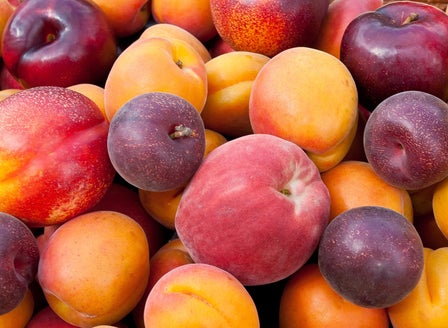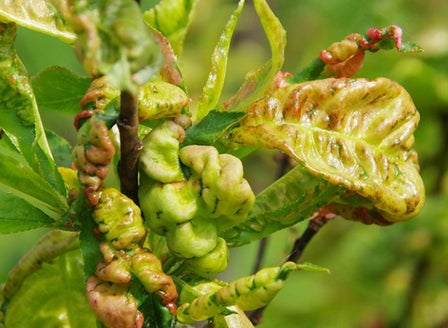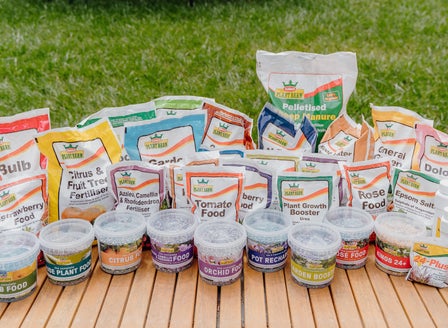What could be better than being able to walk out to your garden and pick your own Nectarine at its freshest and tastiest time. Food tastes better when you've nurtured it and watched it grow to a fully matured plant.
Planting Calendar
Nectarines should be planted from June through to the end of August. Planting should be done in winter when the trees are fully dormant (when they have completely lost their leaves for the season). This is also the best time of year to buy your nectarine trees as this is when we have the greatest selection in store.
Harvest In
2 - 4 Years
Nectarines will be ready to harvest 2 to 4 years after planting. Harvest when fruits give a little when gently squeezed in late summer.
Prepare
Position
Choose a position that gets full sun, or at least 6 hours of direct sunlight daily, protection from wind is also ideal. Plant at least 4 meters apart from other fruit trees, giving them enough space to mature. However, dwarf varieties can be planted in large pots, or spaced 2 meters apart.
Soil
When planted into the ground Nectarines like a free draining soil that is rich in organic matter. To improve the organic content in your soil, break up the soil and add Kings Compost and Kings Sheep Pellets then mix together well. When growing in containers, plant into Kings Container mix. This mix contains added water storage crystals and Saturaid, two products that help maintain moisture in the soil.
Pollination
Most nectarines are self fertile with the exception of dwarf Nectar Babe, which fruits better when planted with Peach Honey Babe.
Plant
When planting into the ground, gently tap the plant out of its pot. Dig a hole twice the depth and width of the plants root ball. Mix Kings Compost into your existing soil at a 50/50 ratio, add Sheep Pellets and Kings Citrus & Fruit Tree Fertiliser, then mix together well. Back fill the hole with this soil, so that when planted the top of the plant’s roots sit level with the surrounding ground. Insert a hardwood stake next to the plant, being careful not to damage the roots, and tie the tree to it for support with tree-tie. Firm the soil down gently and water in well with Aquaticus Organic Garden Booster. In heavier clay soils, where drainage is likely to be an issue, plant onto a raised mound and sprinkle Gypsum Clay Breaker into the bottom of the hole, this helps slowly condition the soil and will help to break down the clay. When planting into containers, plant in Kings Container mix, as this has water retention crystals in it, which will help in keeping the soil moist. Firm the soil down gently and water in well with Aquaticus Organic Garden Booster.
Care
Watering
Watering is essential especially in the first year of planting to allow the roots to get well established. Water slowly allowing the water to sink down into the roots, rather than allowing it to run off the top of the soils surface. Add Saturaid into the soil at planting as this will help channel the water deep down into the root zone. If planted in pots never allow the pot to sit in water.
Feeding
When planted in the ground liquid feed every month with Aquaticus Garden Booster, from Spring through to the end of Autumn, this encourages root growth and increases the microbial activity in the soil. Monthly applications of Kings Sheep Pellets will help with soil conditioning and plant health. In addition, apply Kings Citrus and Fruit Tree Fertiliser in spring and again in autumn to provide the plant all the nutrients it needs. If planted into a container, feed every 3 months with Kings Slow Release Citrus Food, along with monthly applications of Aquaticus Organic Garden Booster this encourages strong roots and a healthy immune system.
Protecting
Protect against birds by draping Bird Netting over the tree as the fruit ripens. Protect from Guava Moth from September through till February use Guava Moth traps to monitor the number of moths present. Place the trap halfway up the tree. One trap will be sufficient for 4 trees. Remember to replace the pheromone every 6 weeks for best results. If there are only small numbers present the trap should be sufficient to control the problem. If you catch more than 12 moths in a 2-week period, spray trees thoroughly with Success Ultra. Spray no more than 4 times in a season.
Mulching
Mulch around the base of the plants (make sure that the mulch does not come into direct contact with the stem of the plant) with Living Earth More than Mulch. Mulching helps to reduce weeds as well as aiding the soil to retain moisture.
Spraying
Stone fruit need a regular spray program, used for prevention rather than trying to treat the problem once it is active. Spray with FreeFlo Copper as per instructions. Spray with Aquaticus Bugtrol to control flower Thrips.
Pruning
The best time to prune your Nectarine tree is in mid-winter, pruning up to a third of the total growth each year. Always prune your trees on a fine day. • Remove all diseased, damaged and dead wood. • Remove any branches that are crossing or rubbing against each other. • Remove all water shoots (long growth sprouts that grow straight up vigorously). • Remove branches that are growing back into the center of the tree, creating an open vase shape. • Always remove major branches by cutting flush to the trunk. • Smaller cuts should be made on an angle about 15mm above an outward facing bud to promote growth away from the centre of the tree. • Seal cuts above 15 mm in thickness with a pruning paste such as GroSafe Organic Pruning Paste.
General Care
When using sprays, chemicals or fertilisers always read the label and follow the instructions. Apply sprays in the evening to avoid harming beneficial insects.
Beginner Tip
Timing and coverage are critical when applying sprays. They are essential in preventing disease spores from multiplying and re-infecting the tree during flowering and coming into leaf.
Expert Tip
Often a large amount of fruit will set from the blossoms. However, letting these all mature poses a risk of small maturing fruit, high humidity levels causing disease, and branch breakage due to heavy crops. To alleviate this problem, thin (remove) immature fruit by up to a half or at least a one third..
Tip
For smaller gardens purchase a double grafted tree, This has two different varieties growing on the one trunk.
Top Varieties
Red Gold
Freestone variety with large fruit with a sweet taste. Dark red skin with blush yellow flesh. A late season variety.
Snow Queen
Early cropper and freestone with large firm flesh that is white with deep red and yellow skin.
Garden delight
Self Fertile, freestone fruit with red skin and yellow flesh. Great for warmer regions. Beautiful large pink blossoms. Great variety to be grown in containers or for smaller gardens.
Flatto Button Bright
As the name says this variety looks like it has been flattened making Flatto a good one for childrens lunch boxes. Producing large crops of sweet tasting yellow fleshed fruit, mid to late season. Absolutely stunning when in blossom.
Frequently Asked Questions
How and when do I prune stone fruit trees?
After fruiting has finished, usually autumn. Take out suckers and branches in the middle. This allows for good airflow.
What type of soil do nectarines prefer?
When planted into the ground Nectarines like a free draining soil that is rich in organic matter. To improve the organic content in your soil, break up the soil and add Kings Compost and Kings Sheep Pellets then mix together well. When growing in containers, plant into Kings Container mix. This mix contains added water storage crystals and Saturaid, two products that help maintain moisture in the soil.
How often should I water my nectarine tree?
Watering is essential especially in the first year of planting to allow the roots to get well established. Water slowly allowing the water to sink down into the roots, rather than allowing it to run off the top of the soils surface. Add Saturaid into the soil at planting as this will help channel the water deep down into the root zone. If planted in pots never allow the pot to sit in water.
When do nectarines ripen in Auckland?
Nectarines will be ready to harvest 2 to 4 years after planting. Harvest when fruits give a little when gently squeezed in late summer.
How can I improve fruit size and quality?
Thin the fruit when they are about the size of a marble, leaving about 15-20cm between each fruit. This reduces competition and allows the remaining fruit to grow larger and sweeter.


